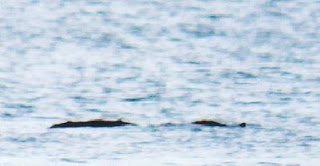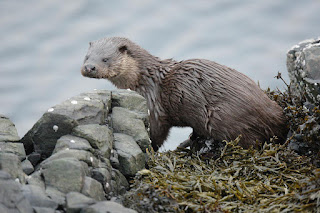On the 23rd May 2011, William Jobes took a series of photographs of the Loch Ness Monster. I have covered this story from the start when it
first came to the attention of the media, which then led to a follow up
article. Late last month, I
published some more of William's pictures taken on a subsequent visit in August 2011.
But I would like to visit the original report as there was some confusion around it at the time. First, I would like to reproduce William's own recounting of the experience which was printed in the February 2012 issue of the "
Fate and Fortune" magazine:
The wind whistled round my ears, as my friend Bruce, 20, and I stood at the top of Urquhart Castle in Inverness, gazing out at the water below. It was April 1969, and we'd come in search of the famous Loch Ness Monster. I'd been determined to catch a glimpse of Nessie since reading about her in a book when I was 14. Most people didn't believe she existed, but I knew there had to be some truth to the dozens of reported sightings.
However, despite taking numerous trips to the loch to look for her over the years, my search had been in vain. Just then, I spotted what looked like a grey hump breaking the surface of the water about three quarters of a mile away. 'Can you see that?' I gasped, looking through my binoculars as a second hump appeared.
'I don't believe it!' Bruce gasped, peering through the camera lens. We began snapping away furiously, until it disappeared a minute later. I was buzzing with excitement. Had we caught Nessie on film? We had the pictures developed the following day, but all they showed was a lens flare from where we'd shot towards the sun. 'Maybe next time,' I sighed. But we had no more luck on any further trips.
Still, I didn't give up hope, even though my wife, Joan, now 58, thought I was nuts. I persuaded her to take yearly trips to the loch with me, where I'd spend hours gazing out at the water, armed with two digital cameras - a small one for taking close-ups and a bigger one for snapping long-distance pictures. Then, on the morning of 23 May 2011, I was on my usual Nessie stake-out when I decided to pop into the nearby village of Fort Augustus for a break.
Dropping off my bigger camera at the holiday cottage where Joan was watching telly, I headed off. On my way back along the water's edge, I heard splashing and turned to see a head poking out of the water about 300 yards away. As it turned towards me, I stared in disbelief. There, looking back at me, was the strangest creature I'd ever seen. It had a protruding snout, like a horse, a sheep-like head, and brown feathery hair, which glistened in the sunlight.
The creature stared right at me with its black bulging eyes the size of apples. Shaking, I fumbled round for my smaller camera and took a snap just as the creature dipped back into the water. I checked my camera. 'Damn!' I cried. The lens was just for close-ups, and I'd only caught the tip of the creature's body. But I was certain of what I'd seen. Grabbing my phone, I rang Joan. 'I saw its head and neck!' I spluttered.
'That's amazing,' she said, although she didn't sound too impressed. No doubt she thought I was imagining things! But now I didn't just believe Nessie existed... I knew she did. The next day, I got up at the crack of dawn and kept watch from the side of the loch. Hours passed, and the sky began to turn dark. I was about to give up and head back to the cottage when I heard a splashing sound and turned to see a huge hump-like shape, 500 yards away.
I was astonished - it looked as if it was over 20ft
long! With my heart racing, I fired off some shots as the hump slid in
and out of the water before disappearing a minute later. Afterwards, I
checked my camera Had my 45-year search finally paid off? I frantically
flicked through my pictures. And there, in the middle of the choppy
loch, was a clear image of the creature's body and tail sticking out of
the water. I'd caught it! I was over the moon as I raced back to show
Joan, who was very impressed. That's not to say my monster-hunting days
are over. I won't rest until I've captured a photo of Nessie's face and
proven to the sceptics that the Loch Ness Monster really does exist.
Watch this space!
William is shown below in a photograph taken at the time. Now the issue with the debate over these pictures at that time was the presumption that William had seen the same "object" over two days. This led to the assumption that since the creatures are not going to appear to anyone two days in a row, then it must be something inanimate floating around which had come in from one of the rivers at Fort Augustus.

However, it is clear from William's own words that the media at the time had mangled his words somewhat and got some things wrong (such as stating his wife was with him at the time). The idea that this was just a piece of garbage floating by does no credit to someone who has made multiple visits to the loch and has accumulated observational experience of the loch over that time.
As he said himself, he thinks he has grasped the ability to tell the difference between a piece of wood and a particular animal. Unfortunately, sceptics do not seem to take an eyewitness' observational abilities into account, which is a most odd omission. William pointed out to me what he thought were ridges on the animal's back and I can certainly see what he is referring to in the photo at the top of the article. I also include these two further back photos taken on the 23rd May 2011 for your consideration which William estimated to be 4-5 feet long.
The final picture below was taken the following day and was estimated to be 20-25 feet long.
Doubtless, the uneven nature of the back was also something that prompted ideas of irregularly shaped garbage floating into Loch Ness. But the natural question to ask is whether anyone else photographed this "
garbage" in the loch? The answer appears to be a big "
No" and when you consider that people at the loch have been quick to publish their own pictures of logs and debris allegedly linked to other sightings in recent years, one wonders how they did not manage to repeat the feat for this object?
But, now we move onto the controversial part of this account and that is William's sketch of the head and neck he observed on that day. You may say what could be more controversial than what has already been published, but you will understand when you see the drawing below and realise what William has sketched is decidedly un-Nessie like.

However, when one says un-Nessie like, we are of course referring to the "received wisdom"
as to what Loch Ness Monsters should look like. Plesiosaur like with
that smooth reptilian skin and barely perceptible eyes. The creature
depicted in this sketch is nothing like that and has more of the "water horse" about it.
Now
if William was making this all up and trying to convince us of the
reality of his fake news, he has gone about in entirely the wrong
manner! If you want to fool people, you stick to plesiosaurs and
antediluvian monsters. So, I have no doubt that William claimed what he
claimed to have seen. But what he saw breaks the Nessie mould. Or does
it?
A look at the overall sightings database has eleven eyewitness accounts describing the head as like that of a horse. That may not sound a lot out of over 1500 reports, but head-neck reports constitute a minority of all reports. Indeed, only 76 of those reports describe the head, making "horse-like" about 15% of such reports. One could also argue that heads described as like a goat, giraffe or deer could be close to "horse-like". As for hair, less than 10 reports mention hair or matted like features while about 17 reports mention a mane or mane-like frill or growth.
No report mentions mane/hair alongside a horse head description, but it could be that the witness implied hair when describing such a head. However, when I was considering William's drawing, I was reminded of another sketch from over fifty years before found in Bernard Heuvelman's book, "In the Wake of the Sea Serpents" which is reproduced below.

This was one of Heuvelman's seven archetypal sea serpents and went by the name of a merhorse. People have since argued for their own classifications and what species such a creature could occupy. But did William Jobes see a merhorse in Loch Ness on that day six years ago?
William has no problem accepting that there may be more than one unknown species of large animal in Loch Ness, be they permanent or visitors. I can see his point of view, but only from a rare visitor point of view. Which begs the question as to what the permanent resident of Loch Ness may be?
The author can be contacted at lochnesskelpie@gmail.com







































































































